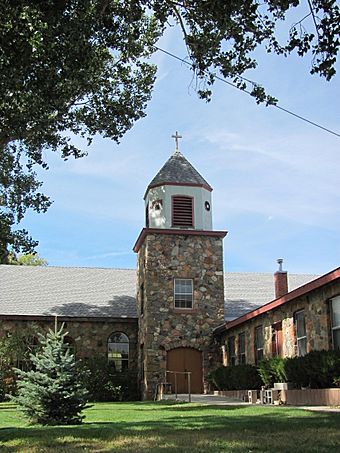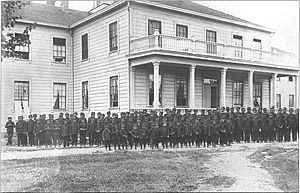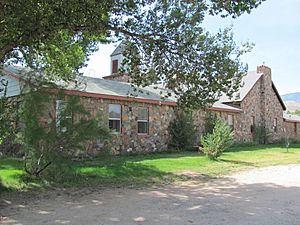Stewart Indian School facts for kids
Quick facts for kids |
|
|
Stewart Indian School
|
|
 |
|
| Lua error in Module:Location_map at line 420: attempt to index field 'wikibase' (a nil value). | |
| Location | S of Carson City off US 395, Carson City, Nevada |
|---|---|
| Area | 109 acres (44 ha) |
| Built | 17 December 1890 |
| Built by | Dept. of Interior Constr. Div. |
| Architect | Frederick Snyder |
| Architectural style | Colonial Revival |
| NRHP reference No. | 85002432 |
| Added to NRHP | 18 September 1985 |
The Stewart Indian School was a special school for Native American children near Carson City, Nevada. It operated for 90 years, from 1890 to 1980. This school was known for its beautiful buildings made from colorful local stone. Students helped build these structures as part of their training.
The Stewart Indian School was the only "off-reservation" boarding school in Nevada. This meant it was not located on a Native American reservation. The school was named after William M. Stewart, Nevada's first senator, who helped get money to build it. It was also known by other names like Stewart Institute and Carson Indian School.
At first, Native American children from Nevada and later from all over the West were required to attend. The school's main goal was to teach them trade skills and help them fit into American society. This often meant they were not allowed to speak their native languages or practice their own cultures. In the early years, students worked hard to help run the school.
Things started to change around 1934 with new laws that supported Native American cultures. The school began to allow students to use their native languages and celebrate their heritage. In 1980, the school closed because the government stopped funding it. Over its 90 years, about 30,000 students attended the Stewart Indian School.
Contents
Life at Stewart Indian School: Learning and Challenges
Senator William Morris Stewart helped create the law that funded this school. It was the only federal Indian boarding school in Nevada that was not on a reservation. The state of Nevada first ordered the school to be built, and then it was sold to the federal government.
For the first 10 years, only children from Nevada's Washoe, Paiute, and Western Shoshone tribes attended. During this time, students could be punished for speaking their native languages. Later, children from over sixty different tribal groups came to the school. These included the Hopi, Apache, and Ute tribes, from many different reservations and hometowns across the Western United States.
Daily Life and Student Work
When the school first opened, it had two dormitories (places for students to sleep), a barn, a carpenter's shop, a laundry, and other buildings. It started with 37 students and three teachers. The school relied on the students' work to keep running. They spent many hours washing clothes, cooking, farming, and doing other manual labor.
In the school's third year, students protested the difficult working conditions. The staff had to talk with the students' parents. This led to students getting grades for their work and being able to keep some of the money they earned from their labor. By the 1930s, between 400 and 500 students attended the school.
Frederick Snyder became the school superintendent in 1919 and stayed until 1934. He helped improve the school's appearance. Students spent half their day on schoolwork, like learning to read and write English. The other half was spent on unpaid work. Boys learned skills like woodworking, farming, and mechanics. Girls learned cooking, sewing, laundry, and nursing.
Changes in Culture and Education
For a long time, the school tried to make Native American children adopt mainstream American culture. They were taught Christian beliefs, and a Catholic church was built next to the school. Students were often not allowed to speak their native languages or practice their customs. They had to cut their hair, wear uniforms, and march to classes. Both students and their parents often disagreed with these rules.
This changed after the Indian Reorganization Act of 1934 was passed. This new law allowed Native Americans to have more control over their own lives and governments. Alida Cynthia Bowler became the Director of Carson Indian School and Reservations after Snyder. She supported these new reforms. She also worked to help tribal councils become stronger. In 1936, she helped organize a cooperative where Native Americans could sell their crafts.
The Bureau of Indian Affairs then encouraged schools like Stewart to let students speak their native languages. They also started to offer classes in native cultures. Starting in the 1960s, the school focused more on academic subjects rather than just job training.
The school closed in 1980 due to government budget cuts and safety concerns about earthquakes. While some students remembered their time at Stewart fondly, others recalled difficult experiences and strict rules.
Beautiful Buildings: The Masonry Work
Frederick Snyder, the superintendent, helped make the school grounds very beautiful. He used colorful local stone from the Carson River to build many of the campus buildings. Much of the stone work on these buildings was done by student apprentices. This means students learned how to build with stone by helping to construct the buildings.
Most of the buildings that still stand today were built between 1922 and the start of World War II. Eventually, the school had over 63 buildings. It also had a large swimming pool and a platform for the Virginia and Truckee Railroad. The railroad stop was used to bring supplies to the school and to transport students. The Stewart Indian School Museum, which is in Snyder's old home, was built by students in 1930.
Stewart Indian School Today
Many of the original buildings from the school are still standing. The school was added to the National Register of Historic Places in 1985. This means it is recognized as an important historical site.
The Washoe Tribe of Nevada and California has a community called the Stewart Indian Colony on and near the former school grounds. The State of Nevada now uses some of the buildings for classes, training centers, and government offices. You can take a walking tour of the former campus, and some items from the school are on display at the Nevada State Museum, Carson City.
In 2017, Governor Brian Sandoval helped get money to fix up the school's old Administration Office and Student Union. These buildings are now the Stewart Indian School Cultural Center and Welcome Center. The cultural center shares the stories of the Native American children who attended the school and the history of the school itself. The school's former post office is now the Welcome Center.
Images for kids





